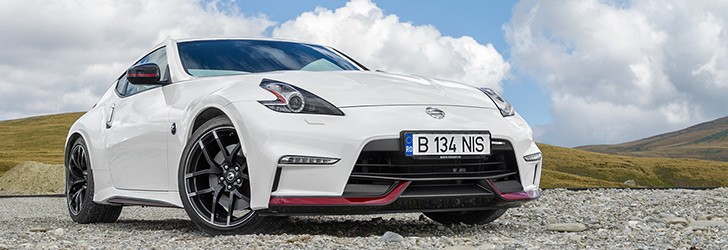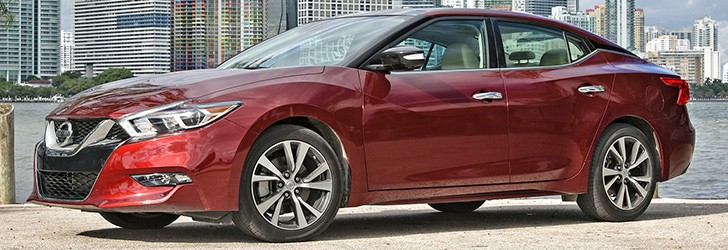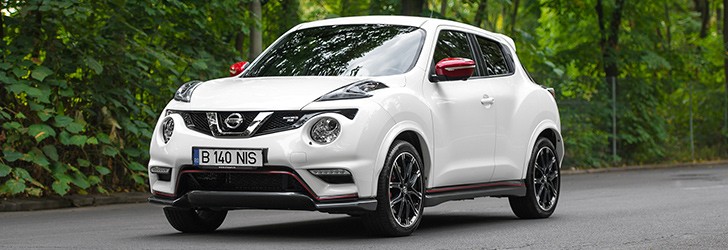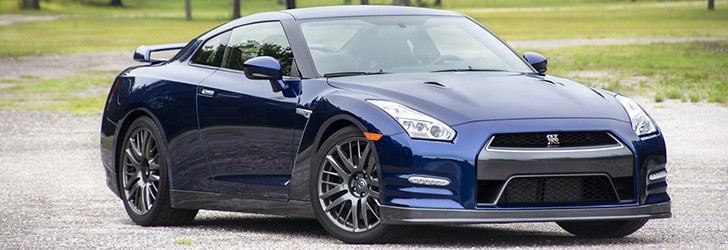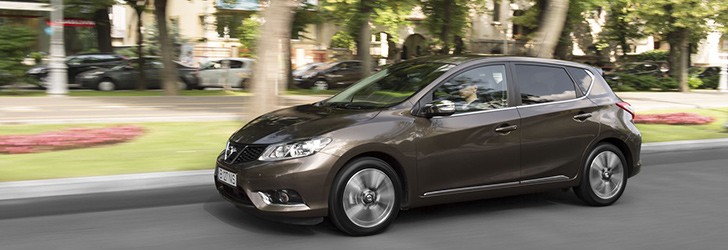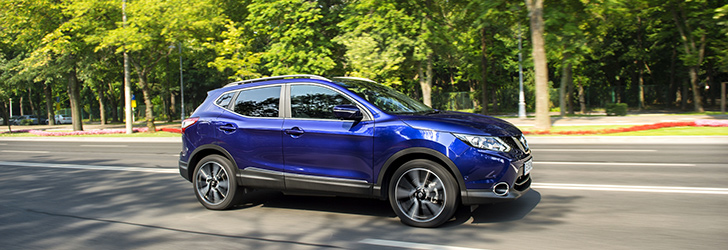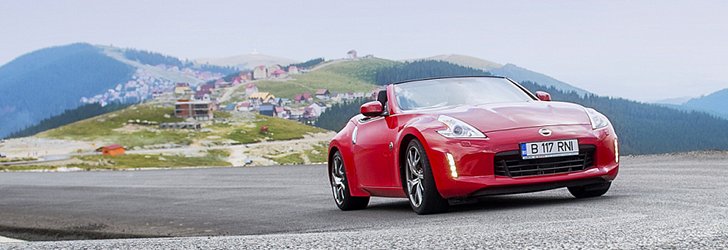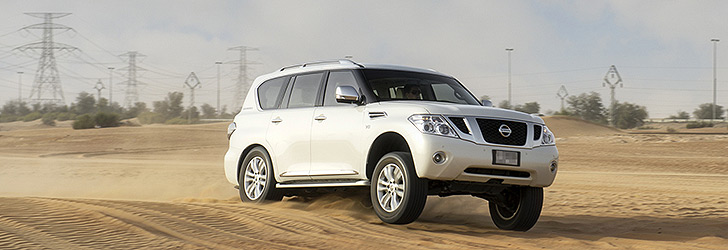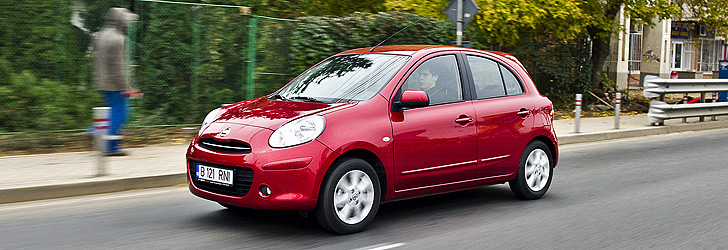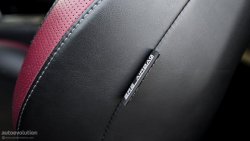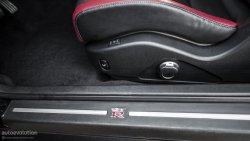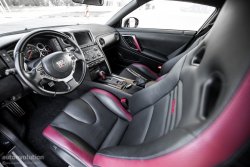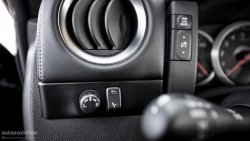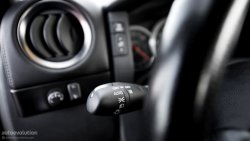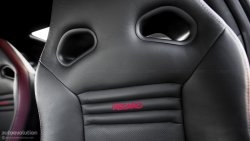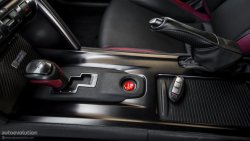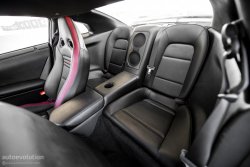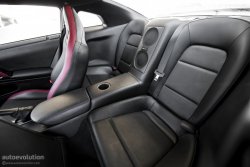NISSAN GT-R Review
OUR TEST CAR: NISSAN GT-R R35 2012
The Nissan GT-R is definitely a supercar that can be used as a daily driver and you can feel that this job was a top priority for the engineers, as all the aspects of the vehicle work together for this goal.
First and foremost, you are offered easy access to a spacious cabin that provides good ergonomics and doubles this with decent visibility. The interior is not perfect though. For example, the materials used are decent, but they don't spoil you in any way.
You have to make extra financial efforts to purchase an actual leather finish and the artificial one on our test car did generate a few problems. The most important one includes the steering wheel: during performance driving, the material caused our hands to sweat more than it was normal, which affected the grip.
The soundproofing is good in general, but the exhaust becomes too noisy during high-speed highway driving. During this kind of use, the car can generate a sound that's similar to the one found in mid-size passenger airplanes and this can become tiring after a while.
The engine proves to be docile when you're not abusing the car and the double-clutch transaxle has no problem with low-throttle driving. The gearbox does generate certain operation noises that can worry one, but the Nissan GT-R's owner manual states that this is normal, explaining that "These noises do not indicate that there is a malfunction."
The suspension of the GT-R is maybe the most interesting aspect of the car as far as this chapter is concerned. In the Comfort mode, this offers one of the most pleasant rides in the segment.
However, you can feel that the suspension has a lot of work to do in order to keep the heavy car on track and the humans inside cozy. For open road driving comfort, it's best to use the Normal setting of the suspension.
When it comes to long trips, the generous luggage compartment and the run-flat tires bring the required peace of mind.
Body and Chassis
The Nissan GT-R R35 is underpinned by a dedicated platform named Premium Midship, with this being the first in the world to combine a front-mounted engine with a transaxle and four-wheel drive.
The vehicle's affordable status meant that making extensive use of exotic materials to keep the down weight was not an option, so the aforementioned materials are only present in a relatively reduced proportion. Thus, steel is used for about 80 percent of the structure, aluminum accounts for roughly 15 percent, while carbon fiber gets the remaining 5 percent.
For example, aluminum is used for the door exterior panels, luggage compartment lid and hood, while the interior part of the doors and front shock absorber towers are made from die-cast aluminum. As for carbon fiber, this can be found in items such as the rear spoiler and the strut brace placed between the aforementioned shock towers, as well as in the rear diffuser and in the part of the underbody that covers the transaxle.
The Nissan GT-R measures 4,671 mm (183.9 in.) in length, 1,895 mm (74.6 in.) in width and is 1,369 mm (53.9 in.) tall. The GT-R offers an incredibly rigid construction, and mixes a drag coefficient of 0.26 with plenty of downforce generated at both ends of the car. In the end, the vehicle couldn't escape the weight penalty, tipping the scales at 1,737 kg (3829 lbs). However, Nissan brags that the car has achieved a perfect balance between weight and grip.
Powertrain
The Nissan GT-R is powered by a 3,799 cm3 V6 unit which, as its VR38DETT suggests, features twin-turbocharging, with the units being supplied by IHI. The unit also features variable valve timing, but it has skipped the direct injection class. The powerplant delivers 550 hp at 6,400 rpm and a peak torque of 628 Nm (463 lb-ft), with the peak torque arriving between 3,200 and 5,800 rpm.
The unit uses an aluminum block, but instead of the traditional cast iron cylinder liners, it comes with plasma-sprayed hardware. The innovative liners dissipate heat better, increasing the efficiency of the engine and also save about 3 kg (6.6 lbs) in this application.
The V6 unit features a secondary air system, which uses a pump to determine a faster catalyst reaction in order to reduce cold-start emissions.
The engine comes with a reduced air flow resistance and to achieve this it features an intake manifold for each unit's head.
The engineers had to adapt all the systems of the GT-R to the extreme lateral g-forces developed during track driving. For example, the engine lubrication system starts with a wet sump layout, but it also offers dry sump functioning through the use of a scavenger pump. The oil pan uses a baffle plate that provides superior stability.
Once we move past the engine, we find Nissan's ATTESA E-TS 4WD system - the designation stands for Advanced Total Traction Engineering System for All-terrain with Electronic Torque Split.
The GT-R receives the most modern incarnation of the system, which uses a transaxle gearbox. We are talking about a BorgWarner double-clutch GR6 unit. The six-speed transmission, which uses dry sump lubrication, offers 200 ms changes. The time isn't impressive for a dual-clutch unit, but the gearbox has other assets that make it shine.
For better packaging and reducing the center of gravity, the transmission casing integrates a transfer case that doesn't use a center differential, but a multi-plate clutch. This uses electronic control to split the power between the two axles. The rear wheels are fed through a limited-slip differential, but the front one receive power via an open diff - a second LSD would've taken the weight and mechanical complexity of the system too far.
However, the front axle receives an electronically simulated LSD - when one of the wheels spins faster than the other, this is braked via an electronic traction control function, which monitors both axles, not just the front one. The system works with Vehicle Dynamic Control (VDC-R) stability control. When this detects unwanted yaw, the system reduces torque sent to the wheels in order to stabilize the car.
In order for the power to travel from the flywheel to the gearbox at the back, this is channeled by a carbon fiber driveshaft. When the front wheels need power too, this is received from the transaxle case via a second driveshaft. The latter is also made of carbon fiber and is placed to the right of the main shaft.
The system is rear-wheel drive biased, but the torque distribution can vary from 100 percent for the rear wheels to a 50:50 split.
The 4WD system performs instant torque delivery adjustments, so it needs to monitor the car and it does this using an array of sensors. These cover variables such as vehicle velocity, transverse and lateral acceleration, tire slip, steering angle and yaw rate.
All the aspects we've mentioned so far were also monitored on the previous incarnations of the GT-R, but the R35 generation adds a sensor for the yaw rate feedback control. This uses the steering angle to calculate the desired yaw rate and compares it with the actual yaw rate, which is measured by the yaw rate sensor and the three-axis G sensor. This is the technical aspect of the GT-R that's most responsible for the car's unique handling.
The AWD system had a dedicated ECU, which makes it pro-active. This means that it doesn't only assist the driver with power delivery, but can also perform operations such as replicating the effects of engine braking when full hydraulic braking pressure is applied.
The Nissan GT-R's ATTESA E-TS system is the technical core of the supercar, the bit that allows it to offer unbelievable performance for its power-to-weight ratio. Nevertheless, its effectiveness would be reduced if it wouldn't work closely together with the active suspension of the vehicle.
Road Connection
The Nissan GT-R's suspension was designed with one main aim: to provide the ideal load balance for all four wheels. This makes use of Bilstein DampTronic adaptive shock absorbers that offer the best characteristics for each wheel, all with the aforementioned goal in mind. For example, when the vehicle reaches a bend, each wheel receives its individual damping setting so that the vehicles stays flat and the load is evenly distributed.
The weight distribution of the GT-R slightly front-biased, sitting at 53:47, but Nissan claims that the suspension system constantly works to keep this at 50:50 during driving.
The suspension system on the GT-R constantly monitors no less than 11 parameters of the vehicle in order to gather data for making adjustments. The elements monitored by sensors include speed, acceleration, lateral acceleration speed, steering angle speed, estimated torque, engine rpm, required torque, ABS status, brake fluid pressure, as well as vehicle stop data.
The engineers have gone to great lengths in order to assure a perfect, all-round balance. For example, the right-hand drive (RHD) versions of the car features an asymmetrical suspension setup. In a RHD GT-R, the weight of the driver adds to the secondary driveshaft and thus the right side of the car has a higher load. To compensate for this, the front spring rate on the left side is harder, while at the back the suspension arm sits upwards on the left and downwards on the right.
When the vehicle is stationary, the aforementioned setup offers an imbalanced wheel load, but when the car is moving, the scheme provides an equal load.
In addition to that, the driver can select one of the three modes available: R, Sports (the default one) and Comfort.
The GT-R rides on forged aluminum 20-inch wheels supplied by RAYS, which come with one distinct feature - knurling is featured inside the rims to prevent the tires to slip during the massive g-forces the car can generate. The wheels are wrapped in Dunlop SP Sport Maxx GT 600 DSST CTT run-flat tires, which come in a size of 255/40ZRF20 up front and 285/35ZRF20 at the rear. You can also order optional Dunlop SP 7010 all-season run-flat tires. Regardless of the choice you make, the tires will arrive filled with nitrogen.
Stopping Power
When the Nissan GT-R needs to lose some of its speed, it relies on hardware supplied by Brembo. The vehicle features ventilated cross drilled steel discs with a diameter of 390 mm (15.35-inch) for the front axle and 380 mm (15-inch) for the rear one. The front axle uses six-piston grabbers, while the rear one relies on four-piston ones. We have to mention that Nissan has upgraded the cooling for the brakes over the years.
We noticed that, like multiple other GT-R's we had met, our test car showed small cracks around the cross drilled holes of the rotors. Nissan relies on the user manual to tell us that these are normal and do not affect the braking performance or reliability. The company explains that "this is due to the temperature differential that occurs because-the surfaces of the disc rotors become hot while the inside of the rotor is still cold."
However, the automaker mentions that if the cracks exceed 0.16 in (4 mm), the discs need to be replaced. In addition to that, Nissan offers optional Brembo SGL carbon ceramic brakes for the GT-R.
If you live in the US, Nissan allows you to choose between three models for the 2014 GT-R: Premium, Black Edition and Track Edition. The GT-R is well equipped even in the Premium equipment level.
We have to start with a feature that defines Godzilla, its Performance Monitor. When Nissan built the car, they appointed Sony Polyphony Digital, the developer of the Gran Turismo racing simulator, to create a special app for the car. This was supposed to offer the drive all sorts of info on the vehicle.
The result can be seen on the GT-R's 7-inch LCD touch-screen display. The GT-R is a god in Gran Turismo and the complexity of the information offered reflects this. Basically you can monitor just about everything, from vehicle dynamics to powertrain parameters, as well as lap times and fuel efficiency. The driver can also choose multiple layouts for how the info is shown.
The aforementioned screen is also used for the infotainment system of the vehicle, so let's see what this is comprised of.
The GT-R features a Bose audio system that uses 11 speakers, including two subwoofers mounted in between the rear seats. This can play MP3s, as well as DVDs and comes with an USB port and Bluetooth connectivity. This Nissan also offers a Nissan HDD-based navigation system with voice recognition.
Other important standard features worth mentioning are UV-treated glass, remote entry and engine start, a two-zone AC system, non-active cruise control, as well as a synthetic leather finish with synthetic suede inserts for the power and heated front seats.
You also get a leather finish for the multifunctional steering wheel, magnesium paddles, gear shifter and handbrake lever.
The Black Edition brings all of the aforementioned goodies, plus a dry carbon rear spoiler, even lighter RAYS forged alloy wheels, as well as carbon Recaro front seats that use a Black & Red artificial leather finish and a dark headliner.
There are only three options available: the cold weather pack, which includes a special coolant and Dunlop all-season run-flat rubber and the Super Silver Special Metallic Paint. The standard paint process of the Nissan GT-R is a six-stage one with two clear coats, but this uses an eight-stage process with three clear coats. In addition to that, you can also opt for a premium interior package - the biggest change comes in the form of Red Amber semi-aniline leather with hand stitching for the front seats.
As for the Track Edition, this borrows the ultra-light wheels and dry carbon rear spoiler of the Black Edition, also adding tech and interior features.
The first include a sportier setup for the suspension and improved brake cooling. Climbing aboard, we find a grip-improving leather & fabric finish for the front seats and a rear seat delete for reduced weight.
If you want to purchase a GT-R in Europe, you'll find that the range structure is largely similar to the aforementioned American one.
However, there are a few small differences. For example, the Premium Edition features hand-stitched genuine semi-aniline leather for the front seats, while the Black Edition offers the carbon Recaro seats as an option.
As for the third model, we have to explain that the US Track Edition is in fact inspired from Track Pack sold in Europe in 2012. For 2013, the package has been made available on more European markets.
Official crash test ratings are not something one can find in the world of supercars and Nissan's GT-R is no exception to this. When the car was conceived, "safety" was one of the words that were often mentioned. The GT-R uses a dedicated platform, so the engineers were able to specifically develop the crash protection areas to fit the profile of the car.
As for its four-wheel drive system, this is one of the quickest-reacting pieces of hardware available. Thus, it can save you from many dangerous situations, providing that you are not wrongfully using its capabilities and generating the conditions that lead to a crash yourself. This is true for any supercar out there, but more so for the GT-R, since driving acrobatics are the headline in this vehicle.
Apart from its technical assets, the GT-R offers a respectable level of safety features. We'll start with the airbags, which include front dual-stage units for the driver and passenger, as well as side and curtain units.
The daytime running lights that use LED technology and the tire pressure monitoring system are also worth mentioning as little things that are there for you during everyday driving.
Normally when the safety of a vehicle is assessed, the active, passive and perhaps on-the-road criteria are sufficient. However, a long history of what could be described as "supercar spontaneous combustion" has taught us to also pay attention to this aspect.
In this respect, if we had to offer an award for the supercar with the least potential to catch fire out of a sudden, we'd probably give it to the Nissan GT-R. That's because, to our knowledge, the vehicle has been placed in the same sentence with "fire" far less than other supercars.
Nissan reinvented its halo car, the GT-R, in order to use it for achieving an image bonus that would serve all the other models of the brand. To make sure that this would draw attention, the carmaker brought it to life as an extremely unconventional supercar.
The current R35 GT-R is a car that was offered for about half the price of a Porsche 911 Turbo when it came out in 2007 and its main aim was to be faster than the German model it was targeting. The Japanese managed to pull this stunt and a proposal which mixed this kind of price with such top-end performance instantly became a hit. In fact, this combination is the best part of the Nissan GT-R and we’ll start with the performance side of the deal.
It doesn't matter if we're talking about the fastest car on the Nurburgring or the quickest one to hit 62 mph, the GT-R's name is among the highest on the list. And the vehicle doesn't just deliver top-tier performance, it also makes this extremely available.
Nissan has packed a plethora of electronics inside the GT-R and, among others, this allows the car to turn its driver into a hero - you can push this car hard anytime, anywhere.
Many feared that the tons of programming language incorporated in the car would ruin the performance driving fun, but this is not the case. The GT-R uses its abilities to sustain yours and the results are impressive. This is true for both clean driving with the best lap times in mind, as well as drifting.
As for the financial side of the deal, the 2014 Nissan GT-R comes with a starting price of $99,590 or €92,400 for European customers. The vehicle is still in a league of its own in terms of pricing, as no other supercar with similar specs can be had for this kind of money.
However, the GT-R’s pricing has come a very long way since the initial 2008 model. Each new model year traditionally comes with a financial bump, but Nissan’s supercar used to cost just under $70,000 when it was born, so it exceeds the aforementioned average increase by a hefty margin. The evolution of the R35 GT-R’s price brings another story within the Renault-Nissan alliance to mind.
We can’t help but observe that both ends of the Nissan-Renault vehicle range share an important characteristic: they are the most affordable vehicles in their class. We’ve already covered the GT-R and as for the second model, we are referring to the Logan range that debuted under Renault’s Romanian low-cost brand, Dacia. The Logan’s hatchback version, the Sandero, is the cheapest new car available on many of the global markets it is offered. The GT-R and the Logan also have another aspect in common: while they are undeniably accessible, they’ve both become significantly more expensive compared to their position at the market launch.
Another good side of the GT-R is its practicality. This is manifested in all aspects of the car, from cabin ergonomics to the settings that allow the driver to make the track-tuned suspension docile. This offers the Nissan GT-R a status that many supercars can only dream of: a good daily driver.
However, in its rush to be the fastest, the GT-R misses a key point that defines a supercar - apart from the moments when you’re manhandling it, it’s got no character. If you drive this car in any other way than using full throttle, you'll be disappointed by the experience and this is definitely the worst part of this Nissan - Godzilla is fierce, it's also loyal, but once the battle it over, don't count on it for having a good time.
This is also one of the reasons for which so many owners turn to the aftermarket world. Yes, the Nissan GT-R has a great potential which tuners are exploiting, but in many cases, they owners take their cars down this road simply because they’re seeking some thrills.
As for the ugly part of the Nissan GT-R, this has to be its interior. The space and the ergonomics are pleasing, but the fit and finish used will never be worthy of a dream car. What's more, this issue mixes with the aforementioned dullness and results in a less-than-memorable driving experience.
The world needs cars like the Nissan GT-R, as making performance more available, both financially and on the road, is a priceless asset. Unfortunately, the Japanese supercar comes with flaws that prevent it from being an offer that can't be refused.
First and foremost, you are offered easy access to a spacious cabin that provides good ergonomics and doubles this with decent visibility. The interior is not perfect though. For example, the materials used are decent, but they don't spoil you in any way.
You have to make extra financial efforts to purchase an actual leather finish and the artificial one on our test car did generate a few problems. The most important one includes the steering wheel: during performance driving, the material caused our hands to sweat more than it was normal, which affected the grip.
The soundproofing is good in general, but the exhaust becomes too noisy during high-speed highway driving. During this kind of use, the car can generate a sound that's similar to the one found in mid-size passenger airplanes and this can become tiring after a while.
The engine proves to be docile when you're not abusing the car and the double-clutch transaxle has no problem with low-throttle driving. The gearbox does generate certain operation noises that can worry one, but the Nissan GT-R's owner manual states that this is normal, explaining that "These noises do not indicate that there is a malfunction."
The suspension of the GT-R is maybe the most interesting aspect of the car as far as this chapter is concerned. In the Comfort mode, this offers one of the most pleasant rides in the segment.
However, you can feel that the suspension has a lot of work to do in order to keep the heavy car on track and the humans inside cozy. For open road driving comfort, it's best to use the Normal setting of the suspension.
When it comes to long trips, the generous luggage compartment and the run-flat tires bring the required peace of mind.
Body and Chassis
The Nissan GT-R R35 is underpinned by a dedicated platform named Premium Midship, with this being the first in the world to combine a front-mounted engine with a transaxle and four-wheel drive.
The vehicle's affordable status meant that making extensive use of exotic materials to keep the down weight was not an option, so the aforementioned materials are only present in a relatively reduced proportion. Thus, steel is used for about 80 percent of the structure, aluminum accounts for roughly 15 percent, while carbon fiber gets the remaining 5 percent.
For example, aluminum is used for the door exterior panels, luggage compartment lid and hood, while the interior part of the doors and front shock absorber towers are made from die-cast aluminum. As for carbon fiber, this can be found in items such as the rear spoiler and the strut brace placed between the aforementioned shock towers, as well as in the rear diffuser and in the part of the underbody that covers the transaxle.
The Nissan GT-R measures 4,671 mm (183.9 in.) in length, 1,895 mm (74.6 in.) in width and is 1,369 mm (53.9 in.) tall. The GT-R offers an incredibly rigid construction, and mixes a drag coefficient of 0.26 with plenty of downforce generated at both ends of the car. In the end, the vehicle couldn't escape the weight penalty, tipping the scales at 1,737 kg (3829 lbs). However, Nissan brags that the car has achieved a perfect balance between weight and grip.
Powertrain
The Nissan GT-R is powered by a 3,799 cm3 V6 unit which, as its VR38DETT suggests, features twin-turbocharging, with the units being supplied by IHI. The unit also features variable valve timing, but it has skipped the direct injection class. The powerplant delivers 550 hp at 6,400 rpm and a peak torque of 628 Nm (463 lb-ft), with the peak torque arriving between 3,200 and 5,800 rpm.
The unit uses an aluminum block, but instead of the traditional cast iron cylinder liners, it comes with plasma-sprayed hardware. The innovative liners dissipate heat better, increasing the efficiency of the engine and also save about 3 kg (6.6 lbs) in this application.
The V6 unit features a secondary air system, which uses a pump to determine a faster catalyst reaction in order to reduce cold-start emissions.
The engine comes with a reduced air flow resistance and to achieve this it features an intake manifold for each unit's head.
The engineers had to adapt all the systems of the GT-R to the extreme lateral g-forces developed during track driving. For example, the engine lubrication system starts with a wet sump layout, but it also offers dry sump functioning through the use of a scavenger pump. The oil pan uses a baffle plate that provides superior stability.
Once we move past the engine, we find Nissan's ATTESA E-TS 4WD system - the designation stands for Advanced Total Traction Engineering System for All-terrain with Electronic Torque Split.
The GT-R receives the most modern incarnation of the system, which uses a transaxle gearbox. We are talking about a BorgWarner double-clutch GR6 unit. The six-speed transmission, which uses dry sump lubrication, offers 200 ms changes. The time isn't impressive for a dual-clutch unit, but the gearbox has other assets that make it shine.
For better packaging and reducing the center of gravity, the transmission casing integrates a transfer case that doesn't use a center differential, but a multi-plate clutch. This uses electronic control to split the power between the two axles. The rear wheels are fed through a limited-slip differential, but the front one receive power via an open diff - a second LSD would've taken the weight and mechanical complexity of the system too far.
However, the front axle receives an electronically simulated LSD - when one of the wheels spins faster than the other, this is braked via an electronic traction control function, which monitors both axles, not just the front one. The system works with Vehicle Dynamic Control (VDC-R) stability control. When this detects unwanted yaw, the system reduces torque sent to the wheels in order to stabilize the car.
In order for the power to travel from the flywheel to the gearbox at the back, this is channeled by a carbon fiber driveshaft. When the front wheels need power too, this is received from the transaxle case via a second driveshaft. The latter is also made of carbon fiber and is placed to the right of the main shaft.
The system is rear-wheel drive biased, but the torque distribution can vary from 100 percent for the rear wheels to a 50:50 split.
The 4WD system performs instant torque delivery adjustments, so it needs to monitor the car and it does this using an array of sensors. These cover variables such as vehicle velocity, transverse and lateral acceleration, tire slip, steering angle and yaw rate.
All the aspects we've mentioned so far were also monitored on the previous incarnations of the GT-R, but the R35 generation adds a sensor for the yaw rate feedback control. This uses the steering angle to calculate the desired yaw rate and compares it with the actual yaw rate, which is measured by the yaw rate sensor and the three-axis G sensor. This is the technical aspect of the GT-R that's most responsible for the car's unique handling.
The AWD system had a dedicated ECU, which makes it pro-active. This means that it doesn't only assist the driver with power delivery, but can also perform operations such as replicating the effects of engine braking when full hydraulic braking pressure is applied.
The Nissan GT-R's ATTESA E-TS system is the technical core of the supercar, the bit that allows it to offer unbelievable performance for its power-to-weight ratio. Nevertheless, its effectiveness would be reduced if it wouldn't work closely together with the active suspension of the vehicle.
Road Connection
The Nissan GT-R's suspension was designed with one main aim: to provide the ideal load balance for all four wheels. This makes use of Bilstein DampTronic adaptive shock absorbers that offer the best characteristics for each wheel, all with the aforementioned goal in mind. For example, when the vehicle reaches a bend, each wheel receives its individual damping setting so that the vehicles stays flat and the load is evenly distributed.
The weight distribution of the GT-R slightly front-biased, sitting at 53:47, but Nissan claims that the suspension system constantly works to keep this at 50:50 during driving.
The suspension system on the GT-R constantly monitors no less than 11 parameters of the vehicle in order to gather data for making adjustments. The elements monitored by sensors include speed, acceleration, lateral acceleration speed, steering angle speed, estimated torque, engine rpm, required torque, ABS status, brake fluid pressure, as well as vehicle stop data.
The engineers have gone to great lengths in order to assure a perfect, all-round balance. For example, the right-hand drive (RHD) versions of the car features an asymmetrical suspension setup. In a RHD GT-R, the weight of the driver adds to the secondary driveshaft and thus the right side of the car has a higher load. To compensate for this, the front spring rate on the left side is harder, while at the back the suspension arm sits upwards on the left and downwards on the right.
When the vehicle is stationary, the aforementioned setup offers an imbalanced wheel load, but when the car is moving, the scheme provides an equal load.
In addition to that, the driver can select one of the three modes available: R, Sports (the default one) and Comfort.
The GT-R rides on forged aluminum 20-inch wheels supplied by RAYS, which come with one distinct feature - knurling is featured inside the rims to prevent the tires to slip during the massive g-forces the car can generate. The wheels are wrapped in Dunlop SP Sport Maxx GT 600 DSST CTT run-flat tires, which come in a size of 255/40ZRF20 up front and 285/35ZRF20 at the rear. You can also order optional Dunlop SP 7010 all-season run-flat tires. Regardless of the choice you make, the tires will arrive filled with nitrogen.
Stopping Power
When the Nissan GT-R needs to lose some of its speed, it relies on hardware supplied by Brembo. The vehicle features ventilated cross drilled steel discs with a diameter of 390 mm (15.35-inch) for the front axle and 380 mm (15-inch) for the rear one. The front axle uses six-piston grabbers, while the rear one relies on four-piston ones. We have to mention that Nissan has upgraded the cooling for the brakes over the years.
We noticed that, like multiple other GT-R's we had met, our test car showed small cracks around the cross drilled holes of the rotors. Nissan relies on the user manual to tell us that these are normal and do not affect the braking performance or reliability. The company explains that "this is due to the temperature differential that occurs because-the surfaces of the disc rotors become hot while the inside of the rotor is still cold."
However, the automaker mentions that if the cracks exceed 0.16 in (4 mm), the discs need to be replaced. In addition to that, Nissan offers optional Brembo SGL carbon ceramic brakes for the GT-R.
If you live in the US, Nissan allows you to choose between three models for the 2014 GT-R: Premium, Black Edition and Track Edition. The GT-R is well equipped even in the Premium equipment level.
We have to start with a feature that defines Godzilla, its Performance Monitor. When Nissan built the car, they appointed Sony Polyphony Digital, the developer of the Gran Turismo racing simulator, to create a special app for the car. This was supposed to offer the drive all sorts of info on the vehicle.
The result can be seen on the GT-R's 7-inch LCD touch-screen display. The GT-R is a god in Gran Turismo and the complexity of the information offered reflects this. Basically you can monitor just about everything, from vehicle dynamics to powertrain parameters, as well as lap times and fuel efficiency. The driver can also choose multiple layouts for how the info is shown.
The aforementioned screen is also used for the infotainment system of the vehicle, so let's see what this is comprised of.
The GT-R features a Bose audio system that uses 11 speakers, including two subwoofers mounted in between the rear seats. This can play MP3s, as well as DVDs and comes with an USB port and Bluetooth connectivity. This Nissan also offers a Nissan HDD-based navigation system with voice recognition.
Other important standard features worth mentioning are UV-treated glass, remote entry and engine start, a two-zone AC system, non-active cruise control, as well as a synthetic leather finish with synthetic suede inserts for the power and heated front seats.
You also get a leather finish for the multifunctional steering wheel, magnesium paddles, gear shifter and handbrake lever.
The Black Edition brings all of the aforementioned goodies, plus a dry carbon rear spoiler, even lighter RAYS forged alloy wheels, as well as carbon Recaro front seats that use a Black & Red artificial leather finish and a dark headliner.
There are only three options available: the cold weather pack, which includes a special coolant and Dunlop all-season run-flat rubber and the Super Silver Special Metallic Paint. The standard paint process of the Nissan GT-R is a six-stage one with two clear coats, but this uses an eight-stage process with three clear coats. In addition to that, you can also opt for a premium interior package - the biggest change comes in the form of Red Amber semi-aniline leather with hand stitching for the front seats.
As for the Track Edition, this borrows the ultra-light wheels and dry carbon rear spoiler of the Black Edition, also adding tech and interior features.
The first include a sportier setup for the suspension and improved brake cooling. Climbing aboard, we find a grip-improving leather & fabric finish for the front seats and a rear seat delete for reduced weight.
If you want to purchase a GT-R in Europe, you'll find that the range structure is largely similar to the aforementioned American one.
However, there are a few small differences. For example, the Premium Edition features hand-stitched genuine semi-aniline leather for the front seats, while the Black Edition offers the carbon Recaro seats as an option.
As for the third model, we have to explain that the US Track Edition is in fact inspired from Track Pack sold in Europe in 2012. For 2013, the package has been made available on more European markets.
Official crash test ratings are not something one can find in the world of supercars and Nissan's GT-R is no exception to this. When the car was conceived, "safety" was one of the words that were often mentioned. The GT-R uses a dedicated platform, so the engineers were able to specifically develop the crash protection areas to fit the profile of the car.
As for its four-wheel drive system, this is one of the quickest-reacting pieces of hardware available. Thus, it can save you from many dangerous situations, providing that you are not wrongfully using its capabilities and generating the conditions that lead to a crash yourself. This is true for any supercar out there, but more so for the GT-R, since driving acrobatics are the headline in this vehicle.
Apart from its technical assets, the GT-R offers a respectable level of safety features. We'll start with the airbags, which include front dual-stage units for the driver and passenger, as well as side and curtain units.
The daytime running lights that use LED technology and the tire pressure monitoring system are also worth mentioning as little things that are there for you during everyday driving.
Normally when the safety of a vehicle is assessed, the active, passive and perhaps on-the-road criteria are sufficient. However, a long history of what could be described as "supercar spontaneous combustion" has taught us to also pay attention to this aspect.
In this respect, if we had to offer an award for the supercar with the least potential to catch fire out of a sudden, we'd probably give it to the Nissan GT-R. That's because, to our knowledge, the vehicle has been placed in the same sentence with "fire" far less than other supercars.
Nissan reinvented its halo car, the GT-R, in order to use it for achieving an image bonus that would serve all the other models of the brand. To make sure that this would draw attention, the carmaker brought it to life as an extremely unconventional supercar.
The current R35 GT-R is a car that was offered for about half the price of a Porsche 911 Turbo when it came out in 2007 and its main aim was to be faster than the German model it was targeting. The Japanese managed to pull this stunt and a proposal which mixed this kind of price with such top-end performance instantly became a hit. In fact, this combination is the best part of the Nissan GT-R and we’ll start with the performance side of the deal.
It doesn't matter if we're talking about the fastest car on the Nurburgring or the quickest one to hit 62 mph, the GT-R's name is among the highest on the list. And the vehicle doesn't just deliver top-tier performance, it also makes this extremely available.
Nissan has packed a plethora of electronics inside the GT-R and, among others, this allows the car to turn its driver into a hero - you can push this car hard anytime, anywhere.
Many feared that the tons of programming language incorporated in the car would ruin the performance driving fun, but this is not the case. The GT-R uses its abilities to sustain yours and the results are impressive. This is true for both clean driving with the best lap times in mind, as well as drifting.
As for the financial side of the deal, the 2014 Nissan GT-R comes with a starting price of $99,590 or €92,400 for European customers. The vehicle is still in a league of its own in terms of pricing, as no other supercar with similar specs can be had for this kind of money.
However, the GT-R’s pricing has come a very long way since the initial 2008 model. Each new model year traditionally comes with a financial bump, but Nissan’s supercar used to cost just under $70,000 when it was born, so it exceeds the aforementioned average increase by a hefty margin. The evolution of the R35 GT-R’s price brings another story within the Renault-Nissan alliance to mind.
We can’t help but observe that both ends of the Nissan-Renault vehicle range share an important characteristic: they are the most affordable vehicles in their class. We’ve already covered the GT-R and as for the second model, we are referring to the Logan range that debuted under Renault’s Romanian low-cost brand, Dacia. The Logan’s hatchback version, the Sandero, is the cheapest new car available on many of the global markets it is offered. The GT-R and the Logan also have another aspect in common: while they are undeniably accessible, they’ve both become significantly more expensive compared to their position at the market launch.
Another good side of the GT-R is its practicality. This is manifested in all aspects of the car, from cabin ergonomics to the settings that allow the driver to make the track-tuned suspension docile. This offers the Nissan GT-R a status that many supercars can only dream of: a good daily driver.
However, in its rush to be the fastest, the GT-R misses a key point that defines a supercar - apart from the moments when you’re manhandling it, it’s got no character. If you drive this car in any other way than using full throttle, you'll be disappointed by the experience and this is definitely the worst part of this Nissan - Godzilla is fierce, it's also loyal, but once the battle it over, don't count on it for having a good time.
This is also one of the reasons for which so many owners turn to the aftermarket world. Yes, the Nissan GT-R has a great potential which tuners are exploiting, but in many cases, they owners take their cars down this road simply because they’re seeking some thrills.
As for the ugly part of the Nissan GT-R, this has to be its interior. The space and the ergonomics are pleasing, but the fit and finish used will never be worthy of a dream car. What's more, this issue mixes with the aforementioned dullness and results in a less-than-memorable driving experience.
The world needs cars like the Nissan GT-R, as making performance more available, both financially and on the road, is a priceless asset. Unfortunately, the Japanese supercar comes with flaws that prevent it from being an offer that can't be refused.
THE END
12
Our NISSAN Testdrives:
Photo gallery (86)

